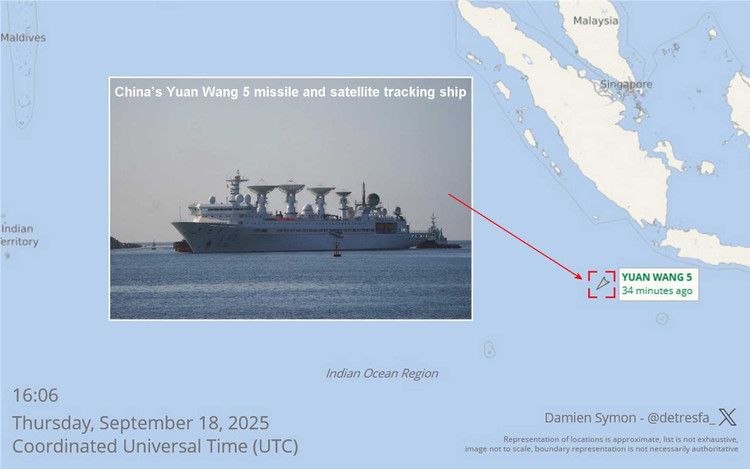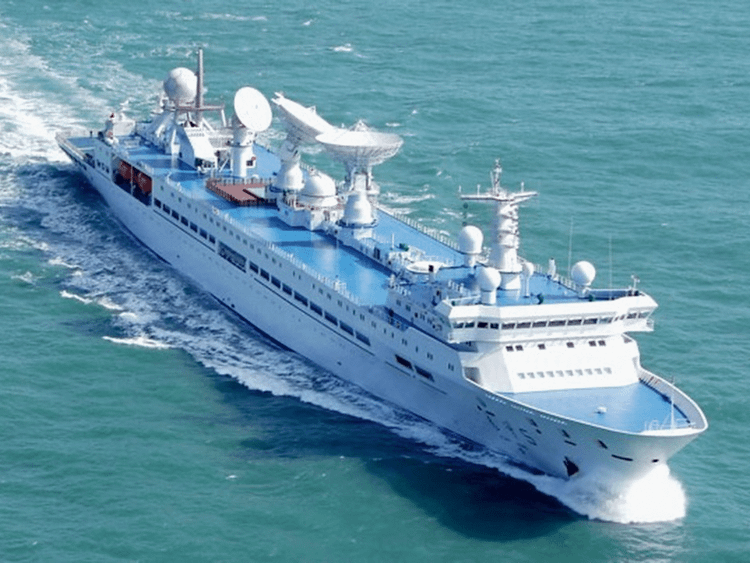China's Yuanwang 5 missile and satellite tracking ship quietly entered the Indian Ocean on September 18, raising new concerns in the United States and India that Beijing is expanding its maritime intelligence capabilities.
The deployment comes at a time of growing US-India security cooperation and raises questions about the Chinese Navy's long-range surveillance ambitions in the Indo- Pacific .

Location of the Yuan Wang 5 ship appearing in the Indian Ocean on September 18. Photo: Damien Symon
The Yuanwang 5 is one of the most advanced missile tracking ships in service with the Chinese Navy. Equipped with large parabolic radar dishes, advanced telemetry receivers and secure satellite communication systems, the ship can detect and record ballistic missile launches, satellite trajectories and naval maneuvers at a range of thousands of kilometers.
Although China describes the ship as a "scientific research platform," defense analysts see it as a strategic asset that combines civil space support with military intelligence, directly providing intelligence to the Chinese Navy far beyond mainland coastal waters.
For India, the ship’s return is more than just symbolic. The Yuanwang 5 made headlines in 2022 when it docked in Sri Lanka, underscoring Beijing’s ability to leverage its South Asian footprint under the Belt and Road Initiative for military purposes.

With a series of powerful phased array radar systems, Thien Vuong 5 makes countries wary every time it appears.
Indian defense officials had expressed concern at the time that the ship could monitor missile tests launched from Indian territory and track the activities of the Indian Navy’s nuclear-powered submarines. The latest deployment comes as India and the United States are conducting the Malabar 2025 naval exercise along with Japan and Australia, highlighting the contested surveillance environment in the Indian Ocean.
US defense officials see the presence of the Yuan Wang 5 as part of a larger Chinese strategy to undermine US intelligence and surveillance dominance.
By placing long-range surveillance assets in waters vital to global energy flows and military logistics, Beijing is demonstrating that it can monitor allied activities, complicate force movements, and potentially provide targeting support for China’s long-range strike systems.

The US, India, Australia and Japan are conducting the Malabar 2025 naval exercise in the waters.
Pentagon planners now see the Indian Ocean as increasingly important to future US-China rivalry, and the presence of Chinese surveillance ships further increases the urgency of investing in underwater sensors, space-based ISR, and unmanned maritime patrol systems.
Strategically, the Yuanwang 5 underscores the growing role of intelligence as a frontline capability in the Indo- Pacific . Naval competition has traditionally focused on aircraft carriers and submarines, but today the ability to monitor, track, and transmit targeting data in real time has become equally important. By deploying such forces into the Indian Ocean, Beijing is no longer demonstrating a regional position but a global intent to challenge the presence of the US and its allies across multiple theaters.
For both the US and India, the deployment reinforces the case for deeper technological integration, from secure satellite communications to shared maritime domain awareness systems. It also strengthens the argument for expanding QUAD ISR cooperation, which analysts say could be as important to deterrence in the long run as deploying more warships.
The Yuan Wang 5’s quiet passage into the Indian Ocean is thus more than just a maritime operation. It is a stark reminder that competition in the Indo-Pacific increasingly hinges on who controls the information environment, a battle where every radar pulse and telemetry data point can tip the balance of power.
Source: https://khoahocdoisong.vn/my-an-do-de-chung-khi-tau-do-tham-trung-quoc-tien-vao-an-do-duong-post2149054267.html























































































![Dong Nai OCOP transition: [Part 2] Opening new distribution channel](https://vphoto.vietnam.vn/thumb/402x226/vietnam/resource/IMAGE/2025/11/09/1762655780766_4613-anh-1_20240803100041-nongnghiep-154608.jpeg)













Comment (0)